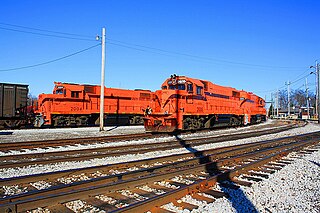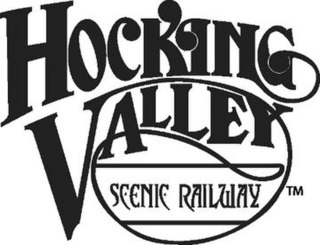
Nanty Glo is a borough in Cambria County, Pennsylvania, United States. It is part of the Johnstown, Pennsylvania metropolitan statistical alrea. The population was 2,734 at the 2010 census. The name comes from the Welsh Nant Y Glo, meaning "The Ravine of Coal."
Heilwood is a census-designated place (CDP) in Indiana County, Pennsylvania, United States. The population was 711 at the time of the 2010 census.

The Wisconsin and Southern Railroad is a Class II regional railroad in Southern Wisconsin and Northeastern Illinois currently operated by Watco. It operates former Chicago, Milwaukee, St. Paul and Pacific Railroad and Chicago and North Western Railway (C&NW) trackage, mostly acquired by the state of Wisconsin in the 1980s.
The Tennessee Central Railway was founded in 1884 as the Nashville and Knoxville Railroad by Alexander S. Crawford. It was an attempt to open up a rail route from the coal and minerals of East Tennessee to the markets of the midstate, a service which many businessmen felt was not being adequately provided by the existing railroad companies. They also wanted to ship coal and iron ore to the Northeastern US over the Cincinnati Southern Railway, which was leased to the Southern and operated as the Cincinnati, New Orleans and Texas Pacific Railway (CNOTP), through their Cincinnati gateway. The N&K was only completed between Lebanon, where it connected to a Nashville, Chattanooga and St. Louis Railway branch from Nashville, and Standing Stone.

The Chicago South Shore and South Bend Railroad, also known as the South Shore Line, is a Class III freight railroad operating between Chicago, Illinois, and South Bend, Indiana. The railroad serves as a link between Class I railroads and local industries in northeast Illinois and northwest Indiana. It built the South Shore Line electric interurban and operated it until 1990, when the South Shore transferred its passenger operations to the Northern Indiana Commuter Transportation District. The freight railroad is owned by the Anacostia Rail Holdings Company.

The Delaware and Hudson Railway (D&H) is a railroad that operates in the Northeastern United States. In 1991, after more than 150 years as an independent railroad, the D&H was purchased by the Canadian Pacific Railway (CP). CP operated D&H under its subsidiary Soo Line Corporation, which also operates Soo Line Railroad.

The Nevada Northern Railway was a railroad in the U.S. state of Nevada, built primarily to reach a major copper producing area in White Pine County, Nevada. The railway, constructed in 1905–06, extended northward about 140 miles (230 km) from Ely to connections with the Western Pacific Railroad at Shafter and Southern Pacific Railroad at Cobre. In 1967 NN reported 40 million net ton-miles of revenue freight on 162 miles (261 km) of line.
The Devco Railway was a Canadian railway. Devco Railway operated as an unincorporated department within the Coal Division of the Cape Breton Development Corporation, also known as DEVCO; as such there is no formally incorporated entity named "Devco Railway". Devco Railway took over the operations of the Sydney and Louisburg Railway on March 30, 1968 when DEVCO expropriated the S&L as part of the assets of the Dominion Steel and Coal Corporation, or DOSCO.
The Sydney Coal Railway is a Canadian short-line railway operating in the eastern part of Cape Breton County, Nova Scotia.

The East Broad Top Railroad (EBT) is a 3 ft narrow gauge historic and heritage railroad headquartered in Rockhill Furnace, Pennsylvania. Operating from 1871 to 1956, it is one of the United States' oldest and best-preserved narrow-gauge railroads, and was designated a National Historic Landmark in 1964. The railroad is now preserved for use as a tourist attraction until operations ceased in 2011. After a nine-year closure, in February 2020 it was announced that the railroad had been purchased by a non-profit foundation and regular train service resumed in the summer of 2021.
Railroad electrification in the United States began at the turn of the 20th century and comprised many different systems in many different geographical areas, few of which were connected. Despite this situation, these systems shared a small number of common reasons for electrification.
The Indiana Rail Road is a United States Class II railroad, originally operating over former Illinois Central Railroad trackage from Newton, Illinois, to Indianapolis, Indiana, a distance of 155 miles (249 km). This line, now known as the Indiana Rail Road's Indianapolis Subdivision, comprises most of the former IC/ICG line from Indianapolis to Effingham, Illinois; Illinois Central successor Canadian National Railway retains the portion from Newton to Effingham. INRD also owns a former Milwaukee Road line from Terre Haute, Indiana, to Burns City, Indiana, with trackage rights extending to Chicago, Illinois. INRD no longer serves Louisville, Kentucky, and the Port of Indiana on the Ohio River at Jeffersonville, Indiana, through a haulage agreement with the Louisville & Indiana Railroad (LIRC).

Wehrum is an abandoned coal mining company town in Buffington Township, Indiana County, Pennsylvania, United States, that thrived for a time during the early 20th century. The mine upon which it was entirely dependent closed in 1929, and the last known inhabitants left in 1934. Essentially all that remains of Wehrum today are shadowy remnants of some of the streets and various building foundations hidden in the woods. Wehrum is now one of the ghost towns included in Pennsylvania's Ghost Town Trail.
The Ghost Town Trail is a rail trail in Western Pennsylvania that runs 36 miles (58 km) between Black Lick, Indiana County, and Ebensburg, Cambria County. Established in 1991 on the right-of-way of the former Ebensburg and Black Lick Railroad, the trail follows the Blacklick Creek and passes through many ghost towns that were abandoned in the early 1900s with the decline of the local coal mining industry. Open year-round to cycling, hiking, and cross-country skiing, the trail is designated a National Recreation Trail by the United States Department of the Interior.
R.J. Corman Railroad/Pennsylvania Lines is a railroad in the R.J. Corman Railroad Group, operating a number of lines in central Pennsylvania. It primarily carries coal between mines and Norfolk Southern Railway connections at Cresson and Keating. The trackage was acquired from Conrail in 1996, when the latter company sold its "Clearfield Cluster"; Norfolk Southern acquired nearby Conrail lines in 1999. This is the longest R.J. Corman owned line, at over 300 miles in length.

The Buffalo and Susquehanna Railroad was a railroad company that formerly operated in western and north central Pennsylvania and western New York. It was created in 1893 by the merger and consolidation of several smaller logging railroads. It operated independently until 1929, when a majority of its capital stock was purchased by the Baltimore and Ohio Railroad. At the same time, the B&O also purchased control of the neighboring Buffalo, Rochester, and Pittsburgh Railway. The Baltimore and Ohio officially took over operations of both roads in 1932.

The Squaw Creek Southern Railroad is a Class III railroad subsidiary of Respondek Railroad operating in the southern portion of the State of Indiana. Originally, the Squaw Creek Southern started operating 21 miles of former Yankeetown Dock Corporation/Peabody Coal trackage owned by Norfolk Southern, but has since started servicing Foresight Energy's Sitran Coal Terminal near Evansville, Indiana and SABIC's Innovative Plastics plant in Mount Vernon, Indiana.

The Hocking Valley Scenic Railway is a non-profit, 501c3, volunteer-operated tourist railroad attraction that operates out of Nelsonville, Athens County, Ohio. It is also located near the popular Hocking Hills State Park in nearby Hocking County. It uses former trackage of the Chesapeake & Ohio Railway, which was in turn originally Hocking Valley Railway trackage. The current operation was founded in 1972.

Colver Historic District is a national historic district located at Barr Township and Cambria Township in Cambria County, Pennsylvania. The district includes 336 contributing buildings, 5 contributing sites, and 3 contributing structures. The district consists of residential areas, coal mining resources, Cambria and Indiana Railroad shop buildings, and a dairy farm associated with the Ebensburg Coal Company's mine and developed between 1911 and 1943. Notable buildings include a variety of brick and frame workers' housing, the Ebensburg Coal Company office building (1914), stone company store (1912), Colver Amusement Company (1912), Colver Hotel (1912), Colver Presbyterian Church (1915), public school (1927), hospital (1914), Roundhouse No. 1 (1918), Roundhouse No. 2 (1920), and main power building (1911).
The Wilmington and Northern Branch is a partially-abandoned railway line in the states of Delaware and Pennsylvania. It was constructed between 1869 and 1870 by the Wilmington and Reading Railroad, a predecessor of the Wilmington and Northern Railroad. At its fullest extent it connected Reading, Pennsylvania, with Wilmington, Delaware. The Philadelphia and Reading Railway leased the line in 1900. With the Reading Company's bankruptcy and the creation of Conrail in 1976 the line's ownership fragmented, and the section between Coatesville, Pennsylvania, and Birdsboro, Pennsylvania, has been abandoned.














